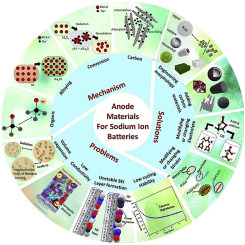Renewable and Sustainable Energy Reviews ( IF 15.9 ) Pub Date : 2019-12-09 , DOI: 10.1016/j.rser.2019.109549 Tahira Perveen , Muhammad Siddiq , Nadia Shahzad , Rida Ihsan , Abrar Ahmad , Muhammad Imran Shahzad

|
With the rapid expansion in energy demands and depletion of fossil fuel reservoirs, the importance of clean energy production and storage has increased drastically. The renewable energy recourses are cost effective, sustainable and carbon dioxide emission free alternatives. Nevertheless, this energy is not always available and needs to be stored. Lithium ion batteries (LIBs) are rapidly used in various applications such as powering electronics, electric vehicles and grid energy storage. However, the increasing concerns regarding load leveling of renewable energy and rise in cost of LIBs due to limited availability of lithium reserves arises doubts whether LIBs alone can meet the rising demands for mid-to-large-scale energy storage. Therefore, attention has been shifted towards development of sodium ion batteries (SIBs) which have wide reserves and low precursor cost and thus is considered as appropriate choice for solar and wind energy development. The prime problem encountered in development of large-scale SIBs is the low effectiveness of appropriate anode material because of large size and sluggish kinetics of Na ions. A comprehensive study regarding anode materials is reported focusing on storage mechanism and structural changes involved during storage of Na ions in various classes of anode materials including carbon-based materials, conversion, conversion/alloying and organic materials. A brief overview of various components of SIBs such as cathode, electrolyte and separator are also discussed.
中文翻译:

钠离子电池负极材料的前景-综述
随着能源需求的迅速增长和化石燃料库的枯竭,清洁能源生产和存储的重要性急剧增加。可再生能源资源是具有成本效益的,可持续的和无二氧化碳排放的替代品。但是,这种能量并非总是可用,需要存储。锂离子电池(LIB)迅速用于各种应用中,例如为电子设备,电动汽车和电网储能供电。然而,由于锂储量有限,对可再生能源的负荷水平和LIB成本上升的担忧日益增加,这引起了人们的质疑,即仅LIB能否满足中大型储能需求的增长。所以,人们的注意力已转移到钠离子电池(SIB)的开发上,该钠离子电池具有广泛的储量和较低的前体成本,因此被认为是开发太阳能和风能的合适选择。在开发大型SIB时遇到的主要问题是,由于Na离子的尺寸较大且动力学缓慢,因此合适的阳极材料的有效性较低。据报道,对阳极材料进行了全面研究,重点研究了各种类型的阳极材料(包括碳基材料,转化,转化/合金化和有机材料)中Na离子存储过程中涉及的存储机理和结构变化。还讨论了SIB的各种组件(如阴极,电解质和隔板)的简要概述。



























 京公网安备 11010802027423号
京公网安备 11010802027423号